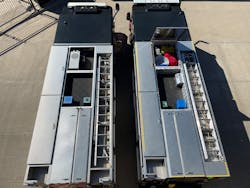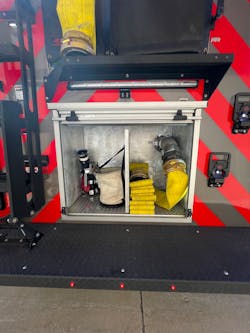Designing Apparatus in the Age of Battery-Powered Tools
The world of battery technology finally has reached the fire service in the same way that it’s revolutionizing the consumer marketplace in almost every aspect of life. You now can find battery-powered hand tools, chainsaws, cutoff saws, extrication tools and ventilation fans. The improvements to this technology have left many wondering whether apparatus-mounted generators are becoming a thing of the past.
One significant benefit that my department found on the apparatus from the elimination of the generator and the transition to battery-powered fans, tools and even extrication equipment (although not completely on our engine) is the compartment space that we gained or repurposed throughout the apparatus body design.
Design planning
If your department made the move to battery-powered tools/equipment or is considering it and the department is about to spec a new piece of apparatus, you must account for a significant increase in electrical needs for the apparatus shoreline.
The first step in that process is to itemize all of the equipment that you carry on your rig that will need to be “plugged in,” or charged, while the rig is in the station. It’s important to provide this information to the apparatus OEM, so electrical draw calculations can be conducted to ensure that you don’t overload a shoreline plug once the vehicle is in service. Although a single battery charger for a drill, let’s say, isn’t a huge draw, the need to charge 8–12 batteries at the same time, not to mention the multitude of other equipment that’s on a rig, certainly could pose electrical-draw concerns. It is entirely possible that a second shoreline might be needed or, perhaps, a larger single-line solution.
I can’t emphasize enough: Make sure that you have the appropriate shoreline or in-station power for your rig’s needs. You don’t want to discover after you push your new rig into the station that you need a 20-amp supply for your shoreline.
Batteries
As you consider which battery-powered equipment that you will carry on your new rig, make sure to review the battery manufacturer guidelines on charging. Although you might free up a large amount of compartment space by removing a generator and other components, some manufacturers recommend a constant charging configuration for their batteries, which isn’t always ideal when batteries are placed inside of a compartment of a fire apparatus. If this is the case, you might need to find an alternative location in the station for charging on a rotating basis.
Additionally, be considerate to the ventilation needs, generally speaking, of the chargers that you utilize. Apparatus compartments aren’t airtight, per NFPA ventilation requirements, so overheating likely isn’t a significant concern for chargers. However, it still is important to ensure that the battery charger has enough space around it to permit proper airflow. You must consult the tool/battery manufacturer guidelines prior to final design layout.
Preplanning your charger locations also helps to avoid power cables strewn throughout body compartments.
Cost
It’s no secret that we have seen skyrocketing costs when it comes to new fire apparatus. I would argue that the cost increases are outpacing by far the budgets of departments. When this happens, departments face the need to find areas in purchasing that they can cut without affecting the operational capabilities of their apparatus.
As you evaluate the purchase of your new apparatus, consider that a hydraulic generator that has two electric cord reels could contribute more than $20,000 to the cost of your new vehicle. Have you asked yourself what you use the generator for and what alternatives to it exist?
During a purchasing process for my department in 2020, we asked those questions, and after many discussions, the best that we could come up with was that our corded PPV fan required a generator. Goodbye corded PPV fan, hello battery-powered model. Although this change was met with a bit of apprehension by some of our firefighters, after having the rig in service for more than a year, we came to realize that the changes that we made were well worth the tradeoffs. Not only did we save money on the purchase of the apparatus, but the lighter weight PPV fan that’s powered by batteries improves our ability to ventilate large apartment buildings by being able to more easily move the fan to the exact locations where it’s needed and to reduce the potential for firefighter lifting injuries by being much lighter.
It also is important to put the cost savings in the context of long-term maintenance. Although you might find some savings in not having a PTO and hydraulic or diesel generator to maintain, there is no doubt that batteries do have a life cycle and that you will be required to replace them over time. Although the cost isn’t significant, it’s better to simply plan ahead than to be surprised by an unforeseen cost in a handful of years when batteries aren’t performing at their highest capacity.
One significant benefit that my department realized from the elimination of the use of a hydraulic generator and the transition to battery-powered fans, tools and even extrication equipment (although not completely on our engine) is the compartment space that we gained or repurposed.
You can regain a significant amount of space on the top of the body where a generator might be mounted. In our case, we replaced this with additional top-of-body storage (coffin compartment), to allow us to carry less frequently used equipment on top, which frees up additional space on the body sides for more commonly utilized equipment.
If your department is replacing an apparatus that has a diesel generator that’s mounted in a side compartment, you just gained an entire compartment that’s located low on the side of your apparatus, which gives back some of the most prime real estate that’s on your rig.
Additionally, the battery-powered PPV fan that we purchased was small enough to be relocated to a side compartment (from a rear compartment), which allows for a completely redesigned rear compartment. In this instance, not only were we able to repurpose this storage space, but we transitioned the entire concept of how to get water into our fire pump by adding a rear intake and removing the operator panel intake. This improves efficiency of our operations and safety of the operator.
With the generator removed from the equation, cord reels no longer were needed in compartments. Although there are low-profile cord reel options, most take up nearly half of the width of the average compartment opening. By eliminating cord reels, departments again can regain valuable space, to allow for the storage of additional batteries or other equipment.
In the same vein, when designing a new apparatus, you might be able to spec a vehicle to be smaller than a previous model was, while still being able to carry the same tools and equipment that you carried on previous larger apparatus.
About the Author

Neil Sjostrom
Neil Sjostrom is the assistant fire chief of the Roseville, MN, Fire Department. He previously served as a firefighter, lieutenant and battalion chief during his 19 years with the department. Sjostrom also serves as therapy/service K9 program coordinator and handler as part of the Therapy Comfort Canine program. He holds a bachelor’s degree in criminal justice from Metropolitan State University.


